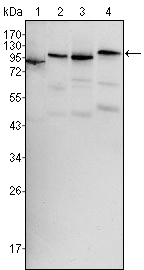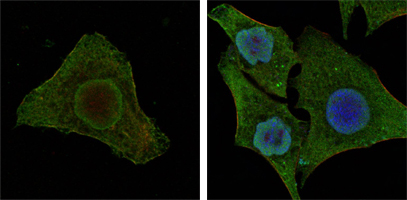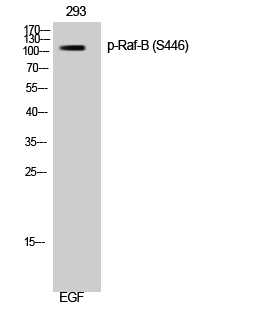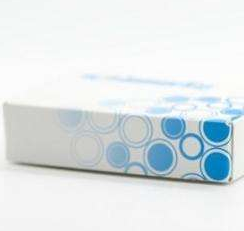Raf-B Monoclonal Antibody
- Catalog No.:YM0549
- Applications:WB;IHC;IF;ELISA
- Reactivity:Human;Mouse
- Target:
- Raf-B
- Fields:
- >>EGFR tyrosine kinase inhibitor resistance;>>Endocrine resistance;>>MAPK signaling pathway;>>ErbB signaling pathway;>>Rap1 signaling pathway;>>cAMP signaling pathway;>>Chemokine signaling pathway;>>FoxO signaling pathway;>>mTOR signaling pathway;>>Vascular smooth muscle contraction;>>Focal adhesion;>>Natural killer cell mediated cytotoxicity;>>Long-term potentiation;>>Neurotrophin signaling pathway;>>Serotonergic synapse;>>Long-term depression;>>Regulation of actin cytoskeleton;>>Insulin signaling pathway;>>Progesterone-mediated oocyte maturation;>>Parathyroid hormone synthesis, secretion and action;>>Cushing syndrome;>>Alzheimer disease;>>Pathways of neurodegeneration - multiple diseases;>>Alcoholism;>>Hepatitis C;>>Hepatitis B;>>Pathways in cancer;>>Proteoglycans in cancer;>>Chemical carcinogenesis - reactive oxygen species;>>Colorectal cancer;>>Renal cell carcinoma;>>Pancreatic cancer;>>Endometrial cancer;>>Glioma;>>Prostate cancer;>>Thyroid cancer;>>Melanoma;>>Bladder cancer;>>Chr
- Gene Name:
- BRAF
- Protein Name:
- Serine/threonine-protein kinase B-raf
- Human Gene Id:
- 673
- Human Swiss Prot No:
- P15056
- Mouse Gene Id:
- 109880
- Mouse Swiss Prot No:
- P28028
- Immunogen:
- Purified recombinant fragment of human Raf-B expressed in E. Coli.
- Specificity:
- Raf-B Monoclonal Antibody detects endogenous levels of Raf-B protein.
- Formulation:
- Liquid in PBS containing 50% glycerol, 0.5% BSA and 0.02% sodium azide.
- Source:
- Monoclonal, Mouse
- Dilution:
- WB 1:500 - 1:2000. IHC 1:200 - 1:1000. IF 1:200 - 1:1000. ELISA: 1:10000. Not yet tested in other applications.
- Purification:
- Affinity purification
- Storage Stability:
- -15°C to -25°C/1 year(Do not lower than -25°C)
- Other Name:
- BRAF;BRAF1;RAFB1;Serine/threonine-protein kinase B-raf;Proto-oncogene B-Raf;p94;v-Raf murine sarcoma viral oncogene homolog B1
- Molecular Weight(Da):
- 84kD
- References:
- 1. J Clin Oncol. 2008 Dec 10;26(35):5705-12.
2. Endocr Relat Cancer. 2006 Mar;13(1):257-69.
- Background:
- This gene encodes a protein belonging to the raf/mil family of serine/threonine protein kinases. This protein plays a role in regulating the MAP kinase/ERKs signaling pathway, which affects cell division, differentiation, and secretion. Mutations in this gene are associated with cardiofaciocutaneous syndrome, a disease characterized by heart defects, mental retardation and a distinctive facial appearance. Mutations in this gene have also been associated with various cancers, including non-Hodgkin lymphoma, colorectal cancer, malignant melanoma, thyroid carcinoma, non-small cell lung carcinoma, and adenocarcinoma of lung. A pseudogene, which is located on chromosome X, has been identified for this gene. [provided by RefSeq, Jul 2008],
- Function:
- catalytic activity:ATP + a protein = ADP + a phosphoprotein.,cofactor:Binds 2 zinc ions per subunit.,disease:Defects in BRAF are a cause of cardiofaciocutaneous syndrome (CFC syndrome) [MIM:115150]; also known as cardio-facio-cutaneous syndrome. CFC syndrome is characterized by a distinctive facial appearance, heart defects and mental retardation. Heart defects include pulmonic stenosis, atrial septal defects and hypertrophic cardiomyopathy. Some affected individuals present with ectodermal abnormalities such as sparse, friable hair, hyperkeratotic skin lesions and a generalized ichthyosis-like condition. Typical facial features are similar to Noonan syndrome. They include high forehead with bitemporal constriction, hypoplastic supraorbital ridges, downslanting palpebral fissures, a depressed nasal bridge, and posteriorly angulated ears with prominent helices. The inheritance of CFC synd
- Subcellular Location:
- Nucleus . Cytoplasm . Cell membrane . Colocalizes with RGS14 and RAF1 in both the cytoplasm and membranes. .
- Expression:
- Brain and testis.
- June 19-2018
- WESTERN IMMUNOBLOTTING PROTOCOL
- June 19-2018
- IMMUNOHISTOCHEMISTRY-PARAFFIN PROTOCOL
- June 19-2018
- IMMUNOFLUORESCENCE PROTOCOL
- September 08-2020
- FLOW-CYTOMEYRT-PROTOCOL
- May 20-2022
- Cell-Based ELISA│解您多样本WB检测之困扰
- July 13-2018
- CELL-BASED-ELISA-PROTOCOL-FOR-ACETYL-PROTEIN
- July 13-2018
- CELL-BASED-ELISA-PROTOCOL-FOR-PHOSPHO-PROTEIN
- July 13-2018
- Antibody-FAQs
- Products Images

- Western Blot analysis using Raf-B Monoclonal Antibody against HeLa (1), HL60 (2), HepG2 (3) and NIH/3T3 (4) cell lysate.

- Immunohistochemistry analysis of paraffin-embedded human testis tissues with AEC staining using Raf-B Monoclonal Antibody.

- Confocal immunofluorescence analysis of MCF-7 (left) and HepG2 (right) cells using Raf-B Monoclonal Antibody (green). Red: Actin filaments have been labeled with DY-554 phalloidin. Blue: DRAQ5 fluorescent DNA dye

